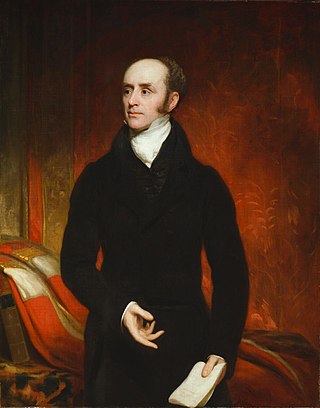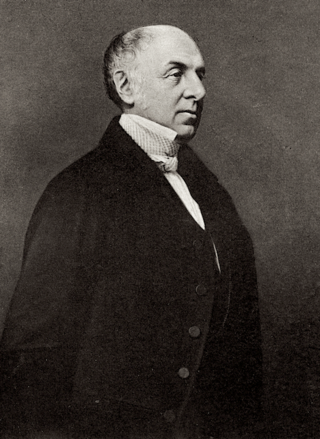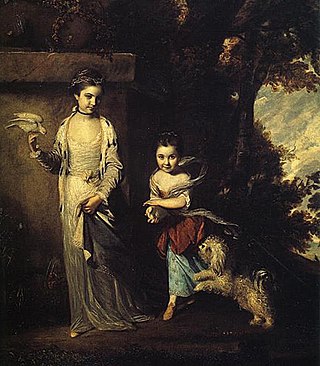
Sir Robert Peel, 2nd Baronet,, was a British Conservative statesman who served twice as Prime Minister of the United Kingdom, simultaneously serving as Chancellor of the Exchequer (1834–1835), and twice as Home Secretary. He is regarded as the father of modern British policing, owing to his founding of the Metropolitan Police Service. Peel was one of the founders of the modern Conservative Party.

Robert Walpole, 1st Earl of Orford,, known between 1725 and 1742 as Sir Robert Walpole, was a British statesman and Whig politician who, as First Lord of the Treasury, Chancellor of the Exchequer, and Leader of the House of Commons, is generally regarded as the de facto first Prime Minister of Great Britain.

Charles Grey, 2nd Earl Grey, known as Viscount Howick between 1806 and 1807, was a British Whig politician who served as Prime Minister of the United Kingdom from 1830 to 1834. He was a descendant of the House of Grey and the namesake of Earl Grey tea. Grey was a long-time leader of multiple reform movements. During his time as prime minister, his government brought about two notable reforms. The Reform Act 1832 enacted parliamentary reform, greatly increasing the electorate of the House of Commons.

William Henry Cavendish Cavendish-Bentinck, 3rd Duke of Portland, was a British Whig and then a Tory politician during the late Georgian era. He served as chancellor of the University of Oxford (1792–1809) and as Prime Minister of Great Britain (1783) and then of the United Kingdom (1807–1809). The gap of 26 years between his two terms as prime minister is the longest of any British prime minister. He was also the fourth great-grandfather of King Charles III through his great-granddaughter Cecilia Bowes-Lyon, Countess of Strathmore and Kinghorne.

Frederick John Robinson, 1st Earl of Ripon,, styled The Honourable F. J. Robinson until 1827 and known between 1827 and 1833 as The Viscount Goderich, the name by which he is best known to history, was a British politician who served as Prime Minister of the United Kingdom from 1827 to 1828.

Sir James Robert George Graham, 2nd Baronet was a British statesman, who notably served as Home Secretary and First Lord of the Admiralty. He was the eldest son of Sir James Graham, 1st Baronet, by Lady Catherine, eldest daughter of the 7th Earl of Galloway.

The National Portrait Gallery (NPG) is an art gallery in London that houses a collection of portraits of historically important and famous British people. When it opened in 1856, it was arguably the first national public gallery in the world that was dedicated to portraits.

Hugh Fortescue, 2nd Earl Fortescue KG, PC, styled Viscount Ebrington from 1789 to 1841, was a British Whig politician.

Sir George Hayter was an English painter, specialising in portraits and large works involving in some cases several hundred individual portraits. Queen Victoria appreciated his merits and appointed Hayter her Principal Painter in Ordinary and also awarded him a Knighthood 1841.

A kit-cat portrait or kit-kat portrait is a particular size of portrait, less than half-length, but including the hands. The name originates from a famous series of portraits which were commissioned from Godfrey Kneller for members of the Kit-Cat Club, a Whig dining club, to be hung in their meeting place at Barn Elms. They are now mostly in the collection of the National Portrait Gallery, London, with a selection of about twelve displayed in London and others at their satellite locations, including twenty on display at Beningbrough Hall in North Yorkshire.

Sydney Prior Hall MVO, MA was a British portrait painter and illustrator and one of the leading reportage artists of the later Victorian period.

The Canningites, led by George Canning and then the Viscount Goderich as First Lord of the Treasury, governed the United Kingdom of Great Britain and Ireland from 1827 until 1828.
Anthony Palliser is a British painter.
Paul Benney is a British artist who rose to international prominence as a contemporary artist whilst living and working in New York in the 1980s and 1990s in the UK as an award-winning portraitist.

Amabel Hume-Campbell, 1st Countess de Grey, 5th Baroness Lucas was a British diarist and political writer who was a countess and baroness in her own right. Had she been male, she would have served in the House of Lords as a Whig. She wrote particularly about the French Revolution.
Delia Mary, Lady Millar C.V.O., was the wife of the British art historian and Surveyor of the Queen’s Pictures, Sir Oliver Nicholas Millar and an art historian in her own right. A specialist in the art of the Victorian era, she was appointed Commander of the Royal Victorian Order in recognition of her services to the Royal Collection.

The Trial of Queen Caroline is an 1823 history painting by the British artist George Hayter. It depicts the events of 1820 in which George IV, who had recently succeeded to the throne, attempted to divorce his long-estranged wife Caroline of Brunswick. In order to secure his divorce George had a special bill moved in the House of Lords. The Lords heard evidence of the Queen's adultery, but with public opinion strongly in Caroline's favour, the measure was ultimately withdrawn by the government. Caroline remained married to George until her death the following year.

The Coronation of Queen Victoria is an 1839 painting by the British artist George Hayter. It depicts in oils the Coronation of Queen Victoria at Westminster Abbey on 28 June 1838. Victoria was eighteen when she succeeded her uncle William IV to the throne on 20 June 1837 and went on to reign until 1901.

The Portrait of Lord Hawkesbury is a work by the English artist Thomas Lawrence depicting the British politician and future Prime Minister Lord Hawkesbury, then in his mid-twenties. It is also known as the Portrait of Lord Liverpool, referring to the title he inherited in 1808 and by which he is better known by. It is in the style of Romanticism.

The House of Commons, 1793–94 is a large history painting by the Austrian artist Anton Hickel. It was first exhibited in 1795 in the Haymarket. It depicts the House of Commons of the Parliament of Great Britain around the time of the country's first involvement in the French Revolutionary Wars. It shows the Prime Minister William Pitt the Younger at the despatch box engaged in debate. A large number of other political figures of the era are also depicted including opposition Whig leader Charles James Fox.

















